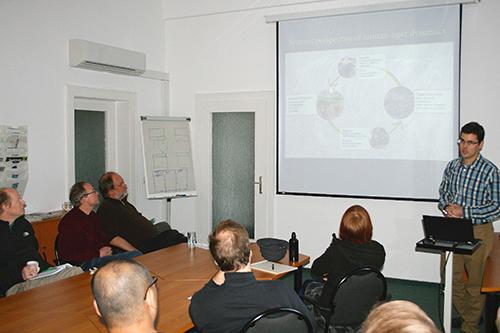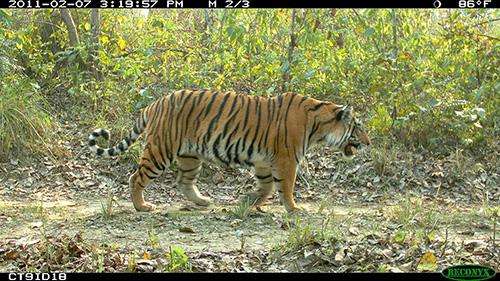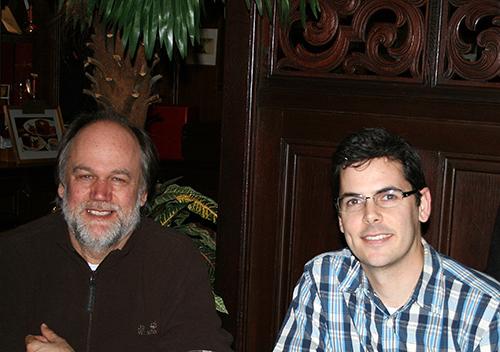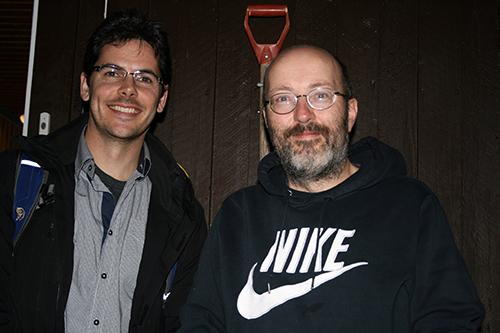
Neil presenting his work in Leipzig, Germany
Large carnivores, such as wolves, bears, and tigers, play many vital roles in our lives. For example, they help maintain resilient ecosystems by regulating hoofed mammal populations (including elk, moose, and zebra) that, if left unchecked, can grow quickly, devastate important plant and tree species, and damage crop fields. Many cultures also have long traditions of hunting large carnivores for fur or as trophies, with myths and stories about the power and grace of these animals reinforcing human–carnivore relationships. Among some cultures in South Asia, large carnivores can serve as vessels for the souls of one’s ancestors. When I was in Nepal for my PhD research, I would see people leave small gifts at animal altars, often symbolizing tigers, to help ensure safe passage through the forests.

Above photo: In Nepal, Neil used camera trapping images such as this one to understand tigers' behavior. Click here to learn more.
On the other hand, predators can threaten human property, livelihoods, and safety. For example, bears occasionally damage orchards, wolves sometimes eat sheep, and tigers can kill people (albeit rarely). But even non-fatal tiger attacks have lasting detrimental effects: In Nepal, I met a man who had survived a tiger attack in the forest, but afterwards began to drink heavily after losing his job as a forest guard and racked up massive hospital bills. We have learned from history that carnivore populations can be quickly and dramatically reduced if local people no longer tolerate their impacts. Most large carnivores now inhabit small fragments of the ranges they once used to roam, largely because of concerted efforts over time by people to remove those animals from human-settled areas.
An important question that emerges then is: can people sustainably coexist with large carnivores, despite a long history of competition for limited resources, such as food and space? What does coexistence even mean precisely? Does it mean letting carnivores only inhabit protected areas set aside from human settlement or development, and thus less likely to negatively impact people? Does it mean finding ways to have carnivores share space with people, despite the likelihood of carnivore-related impacts? Or perhaps a mixture of both approaches depending on context? These questions are difficult to answer, because the relationships between people, carnivores, and the environment are complex and ever-changing.
Fortunately, there are some tools that are useful in exploring these questions.
Agent-based models (ABM) comprise rules for the ways agents (e.g., individual carnivores, individual people) interact with each other and their environment. In this way, ABMs simulate important individual behaviors, like searching for and acquiring food, territories, or mates, that give rise to broad-scale patterns, such as changes in population size. These models can be used to evaluate the potential outcomes of different scenarios on both people and carnivores, and therefore help to inform decision makers in the face of uncertainty. They can help answer, for instance, how certain policies—like handing over management responsibilities of a forest tract to local communities—will change human access to forest products and prey numbers for carnivores while also influencing human hunting of carnivores and carnivore attacks on people. For these reasons, I’m developing an ABM to simulate the interactions between subsistence farmers and the globally-endangered tiger in and around Nepal’s Chitwan National Park, a global biodiversity hotspot. Conservation challenges in Chitwan epitomize those in many places around the world, where reconciling the needs of growing resource-dependent human populations with the desire to protect carnivores is of utmost importance.
Developing a good ABM is no easy task. It requires some programming skills and, more importantly, a clear understanding of how key behaviors and interactions should be best programmed in the model. I recently traveled to the Helmholtz Centre for Environmental Research (UFZ) in Leipzig, Germany, to seek the aid of Dr. Volker Grimm, an ecological modeling guru. SESYNC recently partnered with UFZ to develop a new Theme titled “Biodiversity and Ecosystem Services,” so the timing of my visit was serendipitous. For two weeks in February, Volker spent many hours with me in thinking about the ways to structure the model so that it captures fundamental relationships between tigers and people, such as human impacts on prey and tigers encountering people. The model will therefore provide insights on how to foster human–carnivore coexistence not only in Chitwan, but also in many other places around the world facing similar conservation challenges. I was also fortunate enough to interact with and present my research progress to other scholars at the Centre for Ecological Modelling at UFZ. These scholars are doing top-notch work, and eagerly provided me with valuable input to improve the ABM. For this and many other reasons, my time at UFZ was tremendously rewarding.

Above photo: Neil and Volker Grimm in Leipzig, Germany
My travels and experiences didn’t end at Leipzig, though. I next headed to the Norwegian Institute for Nature Research (NINA) in Trondheim, Norway. There I met with Dr. John Linnell, an expert on the science and practice of carnivore conservation in human-dominated regions around the world. I was keen to pick his brain about what coexistence means from a practical “on-the-ground” point of view. For example, how do managers protect a viable population of a large carnivore that spans a vast region, where some people wish to eliminate the animals at all costs while others with to protect them at all costs? Hint: having decision-making processes that ensure bottom–up representation and participation of various stakeholders is very important. My experiences in both Leipzig and Trondheim helped me build the model and think on how to make it relevant to fostering coexistence across many contexts. At the end of my time in Trondheim, John and I had begun developing a clear, consistent, and comprehensive conceptualization of coexistence. (John also made me moose stew—which was a first for me!)
Though much work remains, my knowledge exchange in Europe has gotten me closer to answering those difficult questions about coexistence. One point made clear is that coexistence is as much about human–human interactions as it is human–carnivore interactions. Moreover, understanding the role of human psychology, ethics, and institutions in carnivore conservation is vital to fostering coexistence. Finally, coexistence requires mutual adaptations by both carnivores and humans and by humans and humans. The next stage for me is to explicitly incorporate these insights on human–carnivore coexistence into a model that advances socio-environment synthesis science and is useful to conservation practitioners and decision makers.

Above photo: Neil and John Linnell in Trondheim, Norway